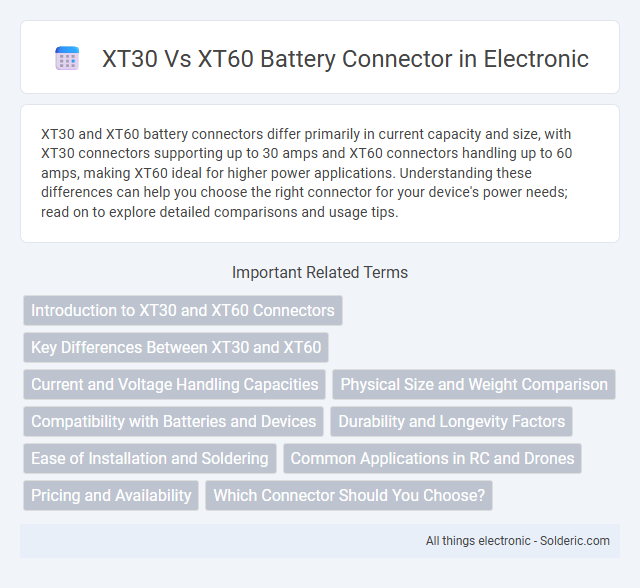XT30 and XT60 battery connectors differ primarily in current capacity and size, with XT30 connectors supporting up to 30 amps and XT60 connectors handling up to 60 amps, making XT60 ideal for higher power applications. Understanding these differences can help you choose the right connector for your device's power needs; read on to explore detailed comparisons and usage tips.
Comparison Table
| Feature | XT30 Connector | XT60 Connector |
|---|---|---|
| Current Rating | Up to 30A continuous | Up to 60A continuous |
| Connector Size | Small, compact (approx. 12x8x9mm) | Larger, durable (approx. 21.5x8.2x7.9mm) |
| Wire Gauge Compatibility | 14-18 AWG | 12-14 AWG |
| Application | Small drones, micro RC models, lower power systems | Medium to large drones, high power RC models, battery packs |
| Weight | ~4.4 grams | ~10 grams |
| Durability | Moderate | High, more robust housing |
| Connector Gender | Male and Female available | Male and Female available |
| Typical Use | Low-current battery connections | High-current battery and ESC connections |
Introduction to XT30 and XT60 Connectors
XT30 and XT60 connectors are commonly used in RC models and drones for secure battery connections. XT30 connectors are smaller, designed for currents up to 30A, making them ideal for lightweight, compact setups. XT60 connectors handle higher currents up to 60A and are preferred for larger batteries and high-power applications requiring reliable, low-resistance connections.
Key Differences Between XT30 and XT60
XT30 and XT60 connectors differ primarily in their current rating and size, with XT30 designed for up to 30A and XT60 supporting up to 60A continuous current. XT30 connectors are smaller, making them ideal for lightweight and compact applications, while XT60 connectors suit higher-power setups requiring robust and secure connections. Your choice depends on the current demands and physical space constraints of your electronic project.
Current and Voltage Handling Capacities
The XT30 connector supports current capacities up to 30 amps and voltage ratings typically around 12-16 volts, making it ideal for smaller drones and lightweight RC models. The XT60 connector handles higher currents up to 60 amps and voltages often reaching 24 volts or more, suited for medium to large-sized battery packs and high-performance applications. Choosing the right connector depends on your battery's current draw and voltage requirements to ensure safe and efficient power delivery.
Physical Size and Weight Comparison
XT30 connectors, measuring approximately 12.8mm by 6.5mm and weighing around 1.9 grams, are significantly smaller and lighter than XT60 connectors, which measure about 21.6mm by 13.5mm and weigh roughly 7.4 grams. This size and weight difference make XT30 connectors ideal for applications where compactness and minimal added mass are critical, such as micro drones or small RC vehicles. Your choice between XT30 and XT60 will depend on the balance between power requirements and the need to minimize physical size and weight.
Compatibility with Batteries and Devices
XT30 connectors are designed for smaller batteries and low-current devices, typically handling up to 30 amps, making them ideal for micro drones and compact electronics. XT60 connectors support higher current loads up to 60 amps, ensuring compatibility with larger batteries used in drones, RC cars, and power-hungry devices. Devices requiring higher power output often mandate XT60 connectors for safe and reliable performance, while XT30 is preferred for lightweight applications with moderate energy demands.
Durability and Longevity Factors
XT60 connectors generally exhibit higher durability and longevity due to their larger contact surfaces and robust gold-plated connectors, which reduce resistance and heat buildup during high current loads. XT30 connectors, while smaller and lighter, are designed for lower current applications and may experience quicker wear under heavy use, impacting their lifespan. Choosing the right connector for Your device ensures reliable performance and extends the battery system's operational life.
Ease of Installation and Soldering
XT30 connectors are smaller and lighter, making them easier to handle and solder for compact RC projects, while XT60 connectors require more space and larger soldering pads, suitable for higher current applications. The XT30's compact design allows for quicker installation, especially if you have limited soldering experience, whereas XT60 connectors offer better durability for heavy-duty use but can be more challenging to solder neatly. Choosing between them depends on your project's current demands and whether ease of soldering or higher power capacity is your priority.
Common Applications in RC and Drones
XT30 connectors are widely used in small to medium-sized RC models and drones, especially those requiring compact, lightweight power delivery under 30 amps. XT60 connectors are favored in larger RC vehicles, drones, and drones with higher power demands, supporting continuous currents up to 60 amps for efficient energy transfer. Both connectors provide secure, reliable connections, with XT60 preferred for high-capacity battery packs in heavy-duty use and XT30 ideal for mini quads, micro drones, and smaller electric RC aircraft.
Pricing and Availability
XT30 connectors typically cost less than XT60 connectors due to their smaller size and lower current capacity, making them a budget-friendly option for lightweight applications. Both XT30 and XT60 connectors are widely available through online retailers and hobbyist stores, ensuring easy access for your battery connection needs. Pricing can vary based on brand and purchase volume, but bulk buying usually offers better value for both connector types.
Which Connector Should You Choose?
Choosing between XT30 and XT60 battery connectors depends on the current requirements and application size. XT30 connectors are ideal for low-current devices, typically handling up to 30 amps, making them perfect for smaller drones or lightweight RC models. Your choice should prioritize XT60 connectors when higher power delivery up to 60 amps is needed, ensuring safety and reliability in larger drones, electric vehicles, or high-performance RC applications.
XT30 vs XT60 battery connector Infographic

 solderic.com
solderic.com